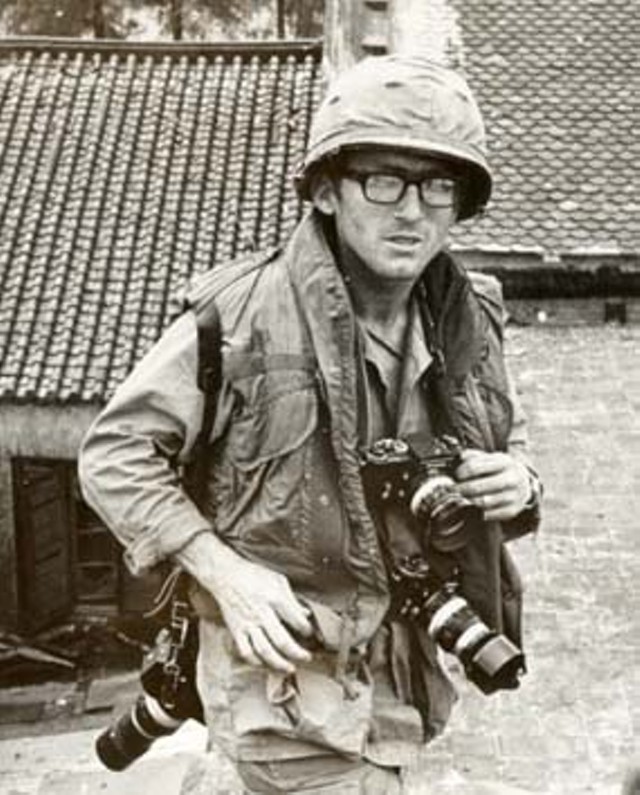Published November 9, 2005 at 3:01 p.m.
The sun was shining on a nearby eucalyptus grove as Mini-Grunt and the Son of Captain Blood roared up Route 1 in eastern Cambodia on their red Honda motorcycles, hoping, perhaps, to be captured by Viet Cong troops. It was April 6, 1970. The two American combat photographers were never seen again.
The Son of Captain Blood was Sean Flynn, whose father, Hollywood's Errol Flynn, had risen to stardom in a 1935 pirate film entitled Captain Blood. Mini-Grunt was Dana Stone, Burlington-born and Wilder-raised. GIs in Vietnam gave Stone that nickname because of his height (5-foot-6) and because they considered him one of them -- just another grunt slogging through the jungle and the paddies, trying to do a job and stay alive.
Stone, who disappeared 12 days shy of his 31st birthday, is also considered "one of the greatest war photographers who ever lived." That's the judgment of Perry Deane Young, a U.S. reporter who spent six months covering the war, and who wrote about Stone and Flynn in a 1975 book entitled Two of the Missing.
"They were amazing photographers," Young said in a recent phone interview from his home in North Carolina, "especially Dana, who was also an amazing person."
A UVM dropout who paid his own way to Vietnam in 1965, Stone was a self-taught photographer, inveterate practical joker and lifelong adventure-seeker. He had persuaded Steve Taylor, then managing editor of The Valley News, to write a To-Whom-It-May-Concern letter affirming that Stone had been assigned by the Vermont-New Hampshire daily to shoot photos of the Vietnam War.
Taylor, now the New Hampshire commissioner of agriculture, remembers Stone showing up at the Valley News office looking like a typical Vermont farm kid. "I figured, 'Why not?' so I batted out the letter," Taylor recalls. "He thanked me and left. That was the only time I saw Dana, and we never did get any photos from him."
Other media outlets would get plenty. One of Stone's photos appeared on the cover of Time in October 1967; others were transmitted all over the world by the Associated Press or broadcast by CBS News.
In Saigon, Stone presented Taylor's letter to officials of the South Vietnam government. Because they could not read English and knew little about the United States, Stone convinced them that The Valley News was basically the same as The New York Times.
He soon finagled a freelance arrangement with United Press International, which agreed to pay Stone up to $20 for each photo. Equipped with a Nikon camera he'd recently picked up in Tokyo, Stone set off to take pictures of U.S. soldiers fighting bloody, losing battles in places such as Khe Sanh, Hue and the Ia Drang Valley.
Today, Stone is memorialized in the War Remnants Museum in Saigon. Among the first exhibits visitors encounter are photos of and by Stone, who is described in one caption as being from Vermont. He is also remembered by journalistic colleagues and some of the soldiers whose hardships he shared. Jack Laurence, formerly of CBS News, wrote a 2002 memoir of the Vietnam War in which he quotes an exchange involving two GIs and CBS cameraman Keith Kay one week prior to Stone's disappearance.
"Where's that funny little guy with the glasses?" one of the GIs asks.
"He sure is a funny little fucker, that guy."
"Most assured-ly had his shit together."
Regrettably, this talented, courageous Vermonter is little remembered in his native state. It seems fitting, then, to pay respects to Dana Stone on this Veterans Day, 35 years after his final assignment.
Those who knew him best describe Stone as insatiably curious, passionate, resourceful and fearless. He was also an impish prankster who would stick his thumb in a fellow newsman's mashed potatoes, or shoot off firecrackers to awaken a bunkmate.
Stone's sister, Bobby Harley, continues to view him as a role model. "I always marveled at his ability to be bold," she says from her home in Florida. "Nothing he did could ever surprise me or anyone else who knew him."
Stone wasn't comfortable in classrooms, Harley recalls. "Dana had trouble sitting down to study," she says. "He'd probably be diagnosed today as having ADHD."
In contrast to this restlessness, Stone's parents were a staid couple deeply rooted in the Connecticut River Valley. Two of the Missing describes Bob and Connie Stone as taciturn Yankees uncomfortable discussing their missing oldest son. Bob Stone, a Navy veteran, worked for the post office. Connie, a teacher and housewife, was the daughter of a local dairy farmer.
"Our parents were supportive. They wouldn't put it in your mind that you couldn't do something," Harley says. "But they certainly didn't influence Dana to live the way he did. I don't think my father ever took a vacation away from home."
The Stones later produced another son, Tom, who worked for 10 years as an instructor at the Mountain Warfare School of the Army National Guard in Jericho, Vt., and who then spent eight years circling the globe on foot. Now 53, Tom Stone lives in Tunbridge -- except that he's currently on his third tour of duty in Afghanistan working as a U.S. Army medic.
Kimball Union Academy in Meriden, N.H., is the only institution that has formally celebrated the life of Dana Stone. In 1991, the boarding school named a photography room in his honor. Stone graduated from Kimball Union in 1958, after winning recognition as an athlete. Harry Black, a friend since childhood, says Stone was motivated to play ice hockey "because he liked to knock people down."
Stone may have been drawn to the wide world out of boredom with life in rural Vermont, Black suggests. The summer after graduation, Stone worked at a textile mill near Quechee, where he would sit in front of a rolling bolt of material and pick off lint with tweezers. "One night he didn't come home from work," Black recalls. "He decided he'd had enough."
Stone later hitchhiked to the Midwest. He lived for a month in a packing crate, then got a job on a freighter in the Great Lakes. After returning to Vermont to study, briefly, at UVM, Stone hitchhiked to California, where he worked on and off for a few years at a logging camp near the Oregon border. During a visit to San Francisco in 1962, Stone met Louise VanDeren Smiser at a North Beach coffeehouse. The two were married at the U.S. embassy in Bangkok in 1968, and lived together in Vietnam throughout Dana's years there.
When not on one of his frequent forays into the combat zones of South Vietnam, Stone would sometimes hang out at "Frankie's House," a Saigon version of a Haight-Ashbury crash pad. Its leading denizen was ace photographer Tim Page. Sean Flynn also spent time at Frankie's House, which was named for a Vietnamese houseboy who regularly acquired some of the best pot in the city.
In his 2002 book The Cat From Hue, Jack Laurence gives readers a taste of the life Dana Stone lived as a '60s hipster in a most unmellow milieu. "By late 1965," Laurence writes, "the Saigon press corps had divided itself between the straights and the crazies, the serious reporters and the cowboys, and those who lived at Frankie's House were counted among the crazies . . . The straights . . . usually obeyed the ground rules and the curfews."
Stone, one of the "crazies," recorded battle scenes that have become emblematic of the United States' defeat in Indochina. He was in the imperial city of Hue after the Viet Cong overran it during the 1968 Tet offensive. Stone also hunkered down alongside the GIs who were surrounded and incessantly fired upon at the Khe Sanh combat base, near the border with North Vietnam.
Most of the time, though, Stone traveled with squads of grunts on search-and-destroy missions where it was seldom clear which side was doing the searching and who was going to be destroyed. In these situations, Stone was most comfortable when he was walking point -- that is, out in front.
"Stone was a lapsed logger from Vermont, 25 years old with 60-year-old eyes set in deep behind wire-rimmed glasses, their shrewdness and experience almost lost in the lean angles of his face," writes Michael Herr in Dispatches, his 1977 war correspondent's chronicle. "We knew for certain that he would be walking well ahead of the rest of the platoon on the trail . . . since he was easily the best equipped man in the party for spotting booby traps or ambushes. But that had nothing to do with his being on point. Dana was the man in motion; he just couldn't slow himself down."
By early 1969, even Stone was burnt out by the war. He and Smiser set off on an overland journey from India to Sweden, where he apparently hoped to work as a logger. Ten months later, however, the couple was back in Vietnam. They may have decided it was the only place Stone could get paid relatively well for what he most loved doing.
The photographer had become determined to establish himself as a TV cameraman, Laurence reports in The Cat From Hue. "He was more serious about his work, more willing to discuss it, more anxious to get a staff job at CBS News."
Laurence recounts a debate he had with Stone in Saigon in late March 1970 over whether Dana should go to Cambodia to cover Viet Cong incursions there, as CBS News officials in New York preferred, or re-enlist with Laurence's TV crew that was accompanying Charlie Company in southwestern Vietnam. Stone opted for Cambodia. "Dana, the tough-minded Yankee individualist who had always followed his own star," Laurence writes, "was becoming a company man."
Whatever his motivation, Stone made a choice that would cost him his life.
Six European and Asian photographers and cameramen had been seized near the village of Chi Phou in Cambodia the day before Stone and Flynn showed up. The missing journalists were believed captured by Viet Cong or North Vietnamese Army troops east of the village. Stone and Flynn laughed off the danger, according to a New York Times correspondent who talked with them the day they disappeared.
Several other reporters who had been captured and released had managed to get exclusive photos or quotes from behind enemy lines -- a feat seen as an enormous boost to one's career. Stone and Flynn "appeared to be trying to become the first American journalists to be taken and released by the other side," Laurence speculates.
Mini-Grunt and the Son of Captain Blood waved jovially as they headed off on their motorcycles, straight into enemy territory. For the next few days, friends back in Saigon remained confident the pair would extricate themselves from whatever weirdness they encountered.
Years after the war ended, Tim Page, the proprietor of Frankie's House, went looking for his friends' remains, or information about their fate. According to the most reliable intelligence, the two photographers were held captive for as long as a year and were then executed, probably by the genocidal Khmer Rouge.
It is impossible to tell Dana Stone's story and not notice parallels to the current war in Iraq. Perry Deane Young, author of Two of the Missing, sees one. "I wish to hell we had a few photographers like them around today," he said last month. "The same things that happened in Vietnam are happening now in Iraq. And if LBJ had said, 'You can't take pictures of caskets coming back,' you can bet that Page, Flynn and Stone would have been out there in a minute."
More By This Author
Speaking of War
-

Burlington City Council Rejects Pro-Palestine Ballot Item
Jan 23, 2024 -

Rep. Balint Reverses Course, Calls for Cease-Fire in Gaza
Nov 16, 2023 -

Protesters Disrupt Balint Fundraiser to Demand Cease-Fire in Gaza
Nov 9, 2023 -

Russian Photojournalist Dmitri Beliakov Brings His Images of War in Ukraine to Vermont
Feb 24, 2023 -

Montpelier-Based 'Russian Life' Magazine Suspends Publication Due to the War in Ukraine
Mar 10, 2022 - More »
Comments
Comments are closed.
From 2014-2020, Seven Days allowed readers to comment on all stories posted on our website. While we've appreciated the suggestions and insights, right now Seven Days is prioritizing our core mission — producing high-quality, responsible local journalism — over moderating online debates between readers.
To criticize, correct or praise our reporting, please send us a letter to the editor or send us a tip. We’ll check it out and report the results.
Online comments may return when we have better tech tools for managing them. Thanks for reading.
















































